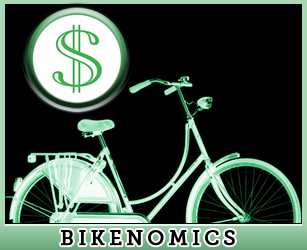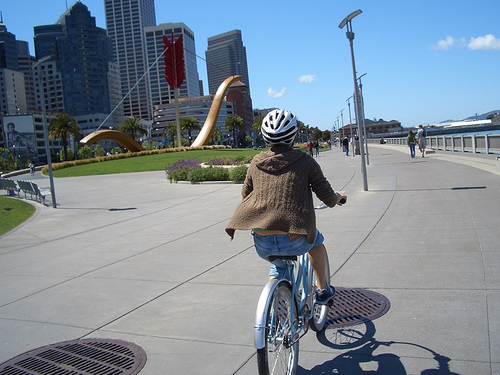This is the second column in a series focusing on the economics of bicycling.
 Here’s one way to fund bicycle infrastructure: Stop building freeways in cities.
Here’s one way to fund bicycle infrastructure: Stop building freeways in cities.
Better yet, tear down the ones we already have.
Cities are starting to catch on that becoming bicycle friendly is one of the best investments they can make.
Cities are also starting to realize that removing freeways makes more economic sense than maintaining or expanding them. In the last year, with the help of federal and state funding, cities like Baltimore and New Haven have been demolishing the “highways to nowhere” that have divided their neighborhoods, drained their populations, and damaged their economies and their children’s health since the 1970s.
Finding room for safe bicycle infrastructure in already strained and contested budgets can be difficult. That’s especially true in places where bicycling has no historical place in the transportation budget, and is still seen as either a whim of the elite or last resort of the poor.
But the economic benefits of freeway removal make anything seem possible.
Our freeway system is crumbling. Freeways in cities are vastly expensive, disastrous for public health and safety, and destructive of community. The damages disproportionately affect the poor.
Urban freeways are also ineffective as transportation solutions. Caught in the vicious feedback loop of induced demand, they cannot be expanded fast enough to keep up with increasing traffic — yet each expansion lures yet more drivers who create yet more congestion and demand more lanes, ad infinitum. The maintenance and expansion of these roadways gobble up transportation funds that could create and maintain less costly and destructive alternatives.
The numbers at play are almost too large to comprehend, but comparison is enlightening.
Bike lanes cost anywhere from $5,000 to $60,000 per mile to add to an existing road. That includes everything from engineering and design to paint and concrete to traffic signals.
Does that seem like a lot? Well, let’s compare.
Freeway construction in Michigan’s countryside clocks in at $8 million per mile. In the state’s cities, with their need for overpasses, underpasses, exits and entrances, and mitigation of construction impacts on health and commerce, the cost jumps to an average of $39 million per mile.
And that’s a bargain-basement rate compared to many parts of the country. On the other end of the spectrum, Boston has the most expensive urban freeway systems in the country, costing over $1 billion per mile.
In Portland, Ore., a single mile of urban freeway costs on average $65 million per mile to build; that’s about the same dollar figure as the entire amount as the city spent in 20 years on the bicycle infrastructure that made it one of the most famous bicycle cities in the world, with a bicycle economy worth far more than that amount every year. For further perspective, it was just announced that $100 million has already been spent on planning for a contentious $4 to $10 billion freeway expansion project here that may never be built.
Those sums don’t include maintenance, which can cost nearly as much as building new miles of freeway, and which, thanks to our interstate system being largely built in a short period of time, is all starting to crumble at once in the last decade — just as federal transportation funding is running out fast. (Remember that bridge in Minnesota?) As early as 2000, the amount of spending needed for basic, safe maintenance of our national freeways and bridges was 20 percent higher than the $30 billion that was spent that year.
By contrast, according to a 2009 report by the League of American Bicyclists, for the $75 million spent repaving three miles of urban interstate, California could have installed 1,250 miles of some of the country’s most expensive bike lanes.
Cities that have chosen (or been forced by citizen groups) to stop building or to remove freeways have been rewarded tremendously, and not just economically.
 The scene today on San Francisco’s Embarcadero, where a freeway once loomed.Photo: Martin DavidssonTalk of removing San Francisco’s Embarcadero Freeway began almost as soon as it was built. When it was taken out of commission by the 1989 Loma Prieta earthquake, it quickly became clear that the predicted traffic snarls weren’t happening; it was demolished and replaced with an arterial street and a now beloved linear park along the water.
The scene today on San Francisco’s Embarcadero, where a freeway once loomed.Photo: Martin DavidssonTalk of removing San Francisco’s Embarcadero Freeway began almost as soon as it was built. When it was taken out of commission by the 1989 Loma Prieta earthquake, it quickly became clear that the predicted traffic snarls weren’t happening; it was demolished and replaced with an arterial street and a now beloved linear park along the water.
When the city of Milwaukee, Wisc. removed a contested, never-finished freeway spur in 2002, the estimated cost for needed safety repairs was $100 million. Removal cost $25 million, and the 26 acres of land freed up for redevelopment attracted over $300 million in investments. Mayor John Norquist, overseeing the project, famously said, “Highways don’t belong in cities. Period.”
President Eisenhower, the father of the U.S. interstate system, agreed. He reportedly only discovered that freeways were being built in cities, rather than between them, in 1959. He wanted them to be eliminated, but the march of progress had already left him behind.
He was right: We don’t need freeways in cities. And we can’t afford them.
Not every city has gotten that message. Right now in Seattle, the earthquake-damaged Alaskan Way Viaduct seems destined to be replaced by a costly freeway tunnel along the city’s waterfront — despite the wishes of voters. In San Diego County, the $2.6 billion proposed for spending on bicycle and pedestrian infrastructure over the next 40 years has attracted more scrutiny than the $82 billion slated for roads in the same plan, including at least one highly contested freeway expansion project. In Portland, planning is underway for a new, widened freeway bridge that will bring more congestion into the center of the city. The ultimate cost of that project is estimated to be between $4 and $10 billion.
There’s a lot of criticism of the cost of bicycle infrastructure. But look at it this way: the simple act of choosing not to build one mile of urban freeway can buy you a world-class bicycle city with a thriving local economy.
We can tear down these freeways and make sure that green spaces, equitable new development, and quality walking and bicycling infrastructure take their place. Soon, we may have no other choice.
Next: “Pedaling away from the health care crisis.”


